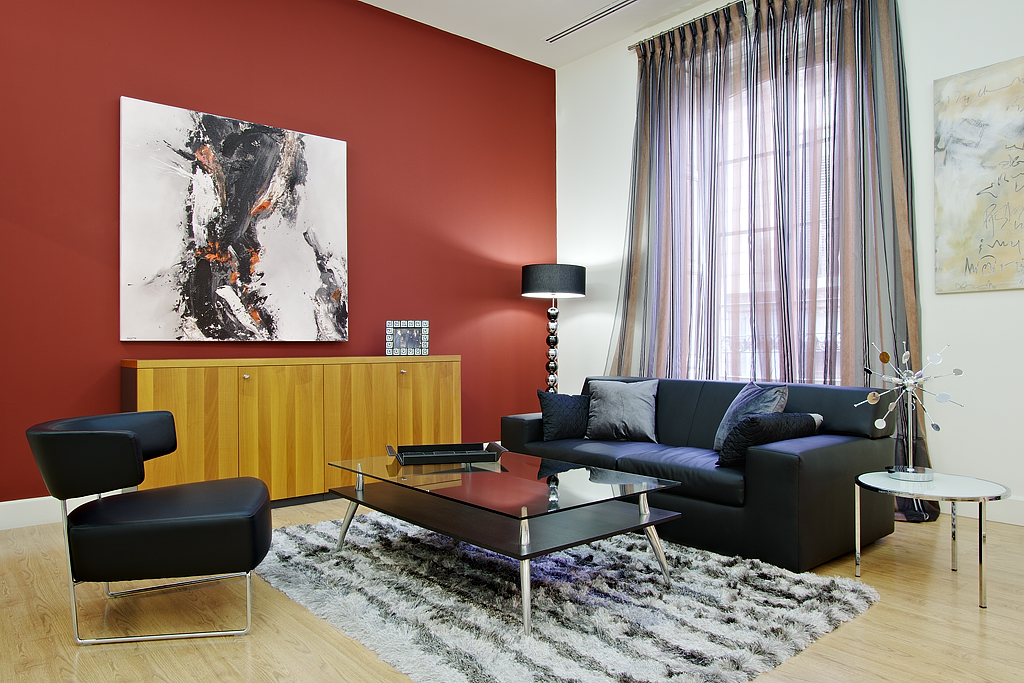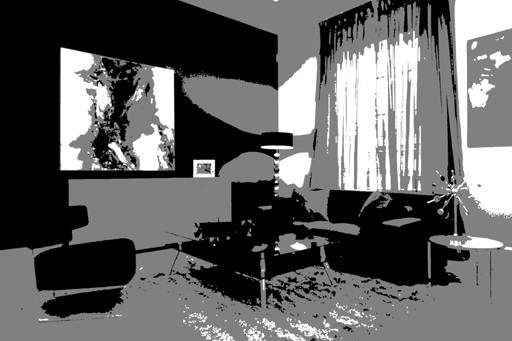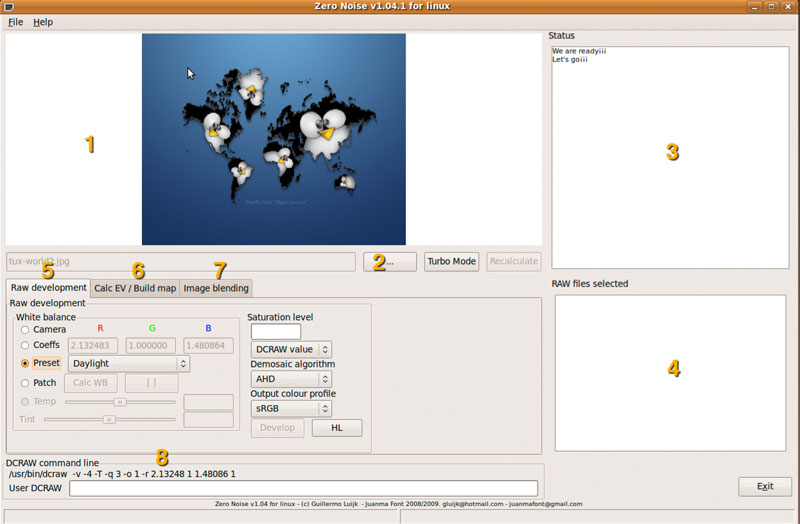Hi everyone,
This is my first post here on the forum. I have been reading extensively because i am trying to learn this HDR technique to hopefully save some time for my work. I shoot a lot of interiors and was hoping that using the HDR merge in CS4 would help me get properly exposed windows into the properly exposed rooms without having to mask it in by hand.
I am not trying to make artistic interpretations of the interiors. I would just like to not have blown out windows in my shots.
I shoot with one of two cameras, either the Canon 5d mark2 or a Rolleiflex 6008 with a sinar Emotion 75 digital back.
So far my experiments in HDR have left me frustrated.
- I am getting a lot of noise
- I am getting some posterization
- It seems like I am losing overall sharpness in the image once merged
- It just does not look as good as any thing I have seen in my research
Furthermore I have at least one question that I could not find explanations for in my research:
My Sinar back does not record my F stop or my exposure time, so when I go to merge these Raw files and/or processed TIFF files photoshop opens a window asking me to set the exposure settings for all the images. I am curious as to why it needs to know this information??? Can i just put anything in at this stage??
Okay I feel like I am asking a lot right now so i will cut my self off so I do not ramble on and on about my failures in this new to me technique. I will be posting more.
Thank you
Please Help
 Helpful Posts: 0
Helpful Posts: 0
Results 1 to 20 of 24
Thread: Some basic HDR questions
-
4th December 2009, 04:19 PM #1New Member

- Join Date
- Dec 2009
- Location
- NYC
- Posts
- 1
Some basic HDR questions
-
4th December 2009, 05:12 PM #2
Re: Some basic questions
Try Picturenaut; it's free and probably easier.
http://www.hdrlabs.com/picturenaut/index.html
You could use the mid emphasis program to generate the HDRI to keep noise low.
-
4th December 2009, 06:19 PM #3
Re: Some basic questions
The only other thing; pixel shift by more than a couple of pixels causes blur. Even if it is lined up in my experience, although limited.
Posturization is caused by stretching the tones too far, but I don't normally have this problem with the above application although the histogram shows it; if it looks alright it is alright. Hope this helps a little and an expert pops along to give better advice.
-
4th December 2009, 08:19 PM #4

- Join Date
- Dec 2008
- Location
- New Zealand
- Posts
- 17,660
- Real Name
- Have a guess :)
Re: Some basic questions
Hi Mar,
Welcome to CiC - it's great to have you with us
Sounds like you have several issues here - we might need to work on them one by one.
Keep in mind that light through windows -v- the correct exposure for an interior can be difficult if for no other reason than the large difference in EV between the two. Getting it technically correct is easy enough, but getting it VISUALLY correct is a different thing altogether; and if you don't then you end up with walls and furniture having a weird ("HDR") look. Two techniques that can make a world of difference are ...
1. Use one or two flashes, and
2. Shoot at a time of day where interior lighting crolles light levels with the external lighting. (I'd show you some examples, but they're on my work PC, and I'm at home now).
Ghosting in composites is due to camera movement - are you using a sturdy tripod, and shooting with either mirror lockup or liveview turned on? If you're needing to change camera settings to get enough of an EV delta in your bracket series then you may be better off controlling the camera from a laptop PC so you don't need to touch it (the 1D series can do 7 shots in a 6EV bracket, but off memory, I think the 5D2 is limited to 4 stops?) (could be wrong).
Noise comes from trying to extract detail from an exposure that's has shadow details too close to the noise floor - which generally means that you didn't have a wide enough EV range in your bracket of exposures. I'd suggest shots 2 stops apart - but - extend the bracket until your shadows are approaching a medium gray.
HDR programs need Exif data because that's how they work out "which way is up" - not literally of course, but it's used as their basic "frame of reference".
Note: These would be great questions for _GUI_ - anyone seen him recently?
-
4th December 2009, 11:09 PM #5
Re: Some basic questions
This is an example HDR with picturenaut, the windows were supposed to be blown a little but it was part of a bigger picture; just somebody there moved a chair.
It will give you an idea though; this is with extreme care and still a two pixel shift. I'm still working on no pixel shift and it is definitely sharper if you get it.

-
5th December 2009, 02:27 AM #6

- Join Date
- Dec 2008
- Location
- New Zealand
- Posts
- 17,660
- Real Name
- Have a guess :)
-
5th December 2009, 03:28 AM #7
Re: Some basic questions
I think that cost more than $1000 just for the flash; can't ever match that so I will have to stick with the HDR and all its problems.
Nice pic though, very sharp. cheers.
-
5th December 2009, 04:33 AM #8

- Join Date
- Dec 2008
- Location
- New Zealand
- Posts
- 17,660
- Real Name
- Have a guess :)
-
7th December 2009, 04:53 PM #9
-
7th December 2009, 11:10 PM #10
Re: Some basic questions
Well this the best I can manage; trouble is I thought the top image looks better , with windows a little blown, not a lot just a little. Of course doing it again I would do better; but sharpness, nothing else.
You would need a lot of flashguns to get detail everywhere, so this is what I'm doing instead. But you have to have a lot between the ears to be able to use all those flasguns; and a lot to not use them.
It's not much better but I know I can do better knowing what is likely to be liked.

-
11th December 2009, 10:26 PM #11

- Join Date
- May 2008
- Location
- Madrid (Spain)
- Posts
- 169
Re: Some basic questions
Some months ago I had a discussion with a professional (and well reputated in Spain) arquitecture and interiors photographer. He liked the same approach as Colin: use support flash lights to fill the darker areas.
I think that approach can be fine, but find another conceptually better (no easier to process, just conceptually better): obtain a noise free image of the scene where shadows can be lifted as much as you can without worrying about noise. If you achieve that, you can obtain a good exposure for every area of the scene without altering the genuine lighting (both in tone and shadow distribution) of the scene.
This second approach is what I do through multishooting at differente exposure values. Then blend the different shots (100% automated process), and finally process the resulting image locally to lift the shadows preserving the highlights.
Only the last tone mapping stage requires manual intervention, but it can be automated just by using the scene's own luminance distribution as the mask for the lift curves.
This is what I did in these sample scenes:
-
12th December 2009, 02:22 AM #12

- Join Date
- Dec 2008
- Location
- New Zealand
- Posts
- 17,660
- Real Name
- Have a guess :)
Re: Some basic questions
Hi Guillermo,
They certainly are great looking images - exceptionally clean looking.
To my eye they seem to have a tendency to up-shift the midtones slightly, giving a slightly different look; is that something intentional, or just a consequence of the HDP process you use?
By the way, where have you been recently? - I've missed your input on HDR matters
-
12th December 2009, 03:35 AM #13

- Join Date
- May 2008
- Location
- Madrid (Spain)
- Posts
- 169
Re: Some basic questions
Hi Colin,
My processing and colours could in fact be totally wrong since in the last months I only used my non calibrated laptop screen. I bought a new 24" HP monitor one year ago, but haven't even used it once (shame on me).
The images look clean just because of the absence of noise; sometimes I think they look like 3D renders. Funily last week I came across a site from a guy from my hometown (Alicante in the East Spanish coast): he does photoreallistic 3D animations. I noticed one of the ingredients to achieve that reallistic look is the addition of noise in the 3D animation software. Very recommended to look at this virtual animation, all of it could be made with a video camera. The guy's site is: http://www.thirdseventh.com/.
I ended my sabbatic year in July and getting used to my new job is being quite exhausting, that's why I reduced participation in forums.
Regards.
-
12th December 2009, 10:05 AM #14
Re: Some basic questions
Hi GUI; I was wondering if your noise reduction software is going to be made commercially available for windows; I'm impressed by the results but don't want to use a command line driven program, such is the thing of the past like fortran card format which I disliked intensely.
Now I like to let the computer take the strain and use sliders with the option of entering digits.
I think your images are very clean even clinical in appearance; I am very impressed.
-
12th December 2009, 10:16 AM #15

- Join Date
- Dec 2008
- Location
- New Zealand
- Posts
- 17,660
- Real Name
- Have a guess :)
-
12th December 2009, 10:44 AM #16
Re: Some basic questions
It probably is for a software developer Colin. I can remember a course in C++ where the Boreland compiler had a lot of reusable code, such as edit boxes ect.
But it has been a long time since doing that and generally like my programs certified and everything self installing to get past my security which likes to rip out what it thinks is dangerous.
I think GUI should make a commercial version of his program which I think is more worth while spending money on than photomatix.
-
12th December 2009, 04:50 PM #17

- Join Date
- May 2008
- Location
- Madrid (Spain)
- Posts
- 169
Re: Some basic questions
Hi men, no idea what made you think my program Zero Noise hasn't a GUI. It has, and the program is free, existing both versions for Windows and for Linux.
Some gentle POTN forum user took time to write a summarized and translated into English version of the original tutorial here: http://photography-on-the.net/forum/...d.php?t=775795.
This is the Windows GUI:
and this is the Linux GUI (running on a Mac BTW):
Regards
-
12th December 2009, 06:52 PM #18
Re: Some basic questions
Well I can see two options; do I need both or one and please no changing directory assigned names using command line or dos instructions. I'm dyslexic and more likely to make a mistake.
I think your program is superior and exactly what I'm looking for; so which one or both considering I'm not dropping my security (Kasperski) to do it.
My C++ programs got wiped out by Kasperski and I would like to just pay for it than the hassle of compromising security, I'm not intersested in that stuff anymore. I just want to make one good photo.
DESCARGAR ZERO NOISE V0.9
DESCARGAR ACTUALIZACIÓN V1.05
-
12th December 2009, 08:45 PM #19

- Join Date
- Dec 2008
- Location
- New Zealand
- Posts
- 17,660
- Real Name
- Have a guess :)
Re: Some basic questions
I guess I'll have to start by pointing out the irony of us thinking that "_GUI_" wasn't "GUI"!
Seriously though, I did think is was command line only ... I haven't used it personally, and I think the non-gui thoughts came from reading discussions about it here about a year ago?
Is turning it into a commercial product on the cards?
-
12th December 2009, 09:25 PM #20

- Join Date
- May 2008
- Location
- Madrid (Spain)
- Posts
- 169
Re: Some basic questions
I am not sure about what to do with ZN since I am not a pro developer, and if you intend to sell software it must work and it must be maintained and supported. That's a lot of mess, and I wonder if worth the money.
My idea now is to write a DNG output version, i.e. Zero Noise producing an undemosaiced RAW file free of noise, so that everyone can use the DNG file in his preferred HDR workflow, including the RAW development stage.
I was happy with the present TIFF version (that ironically for some technical reasons produces more robust images than any 16-bit DNG will support), but when I bought a second hand 5D and saw that DCRAW (the development engine ZN uses) doesn't produce optimum results with 5D RAW files, I thought I _needed_ a DNG version myself. I want to start the DNG version after Christmas and see how it goes.
arith the version you must install is 0.9 which is the installer, and then replace the .exe file it installs by the newest version (1.05 at this moment) provided in the second link. There is a readme.txt with instructions.
If you have Linux, the Linux version is much faster (the guy who translated my VB code into C++ is a fanatic of optimisation), but you'll need some skills in Linux to make it run.
The Windows version is now limited to blending 2 RAW files. With more it adds a watermark I am still thinking if eliminating or not.
Regards


 Reply With Quote
Reply With Quote








